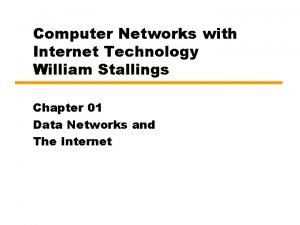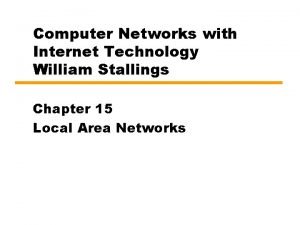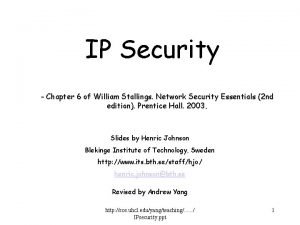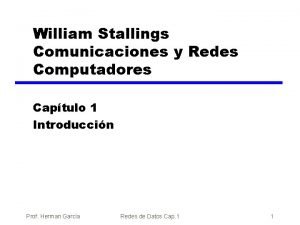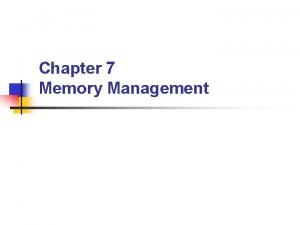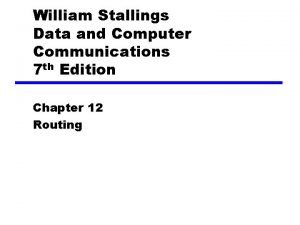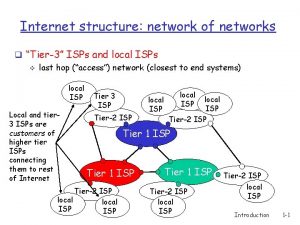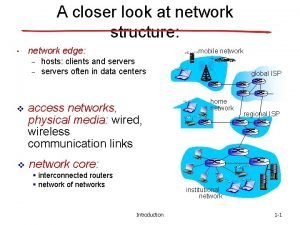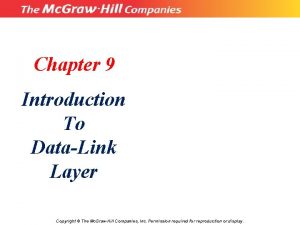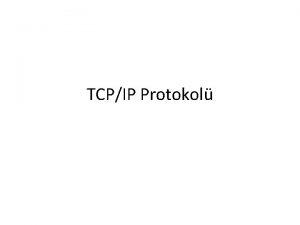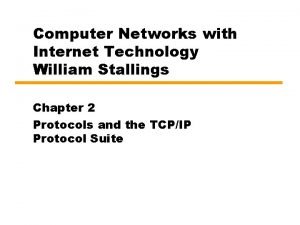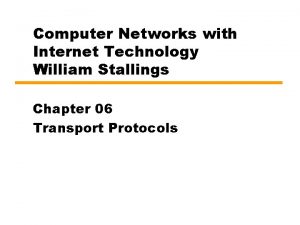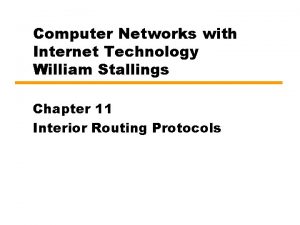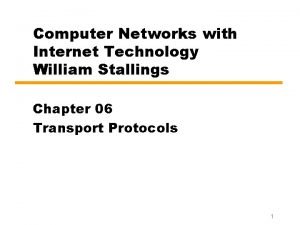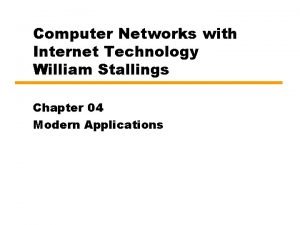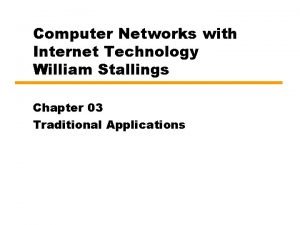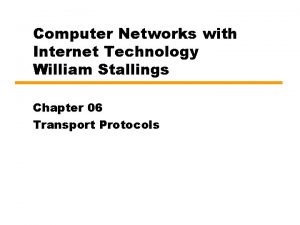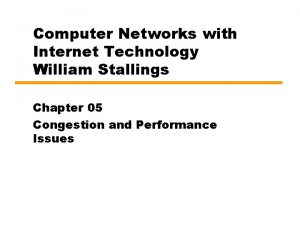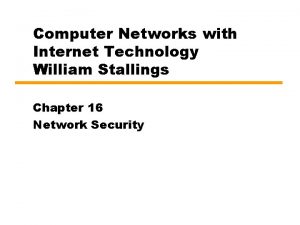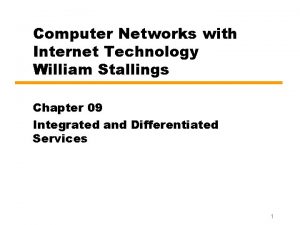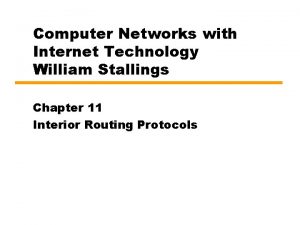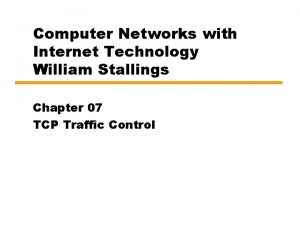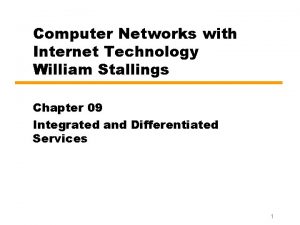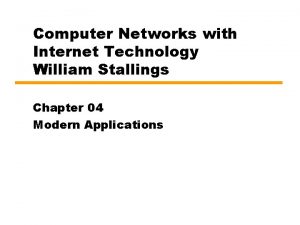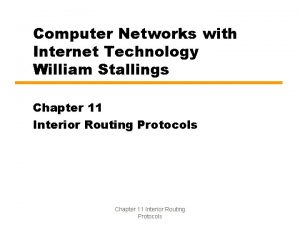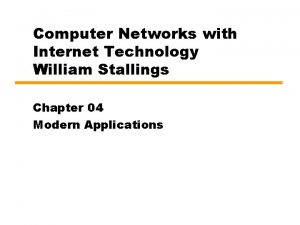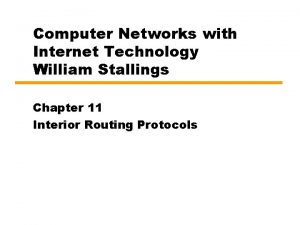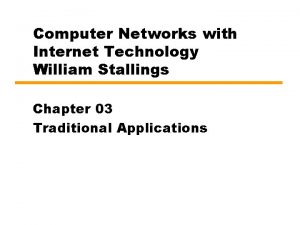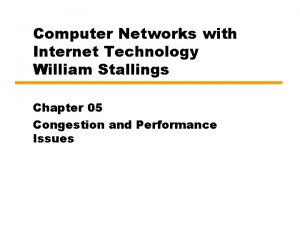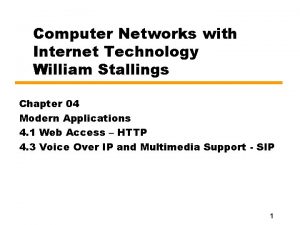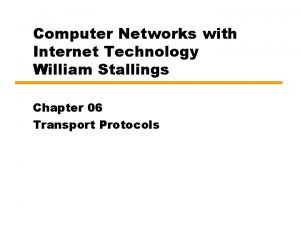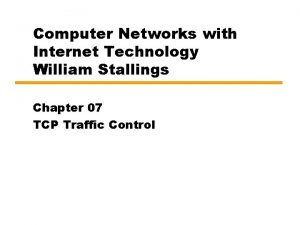Computer Networks with Internet Technology William Stallings Chapter



































- Slides: 35

Computer Networks with Internet Technology William Stallings Chapter 09 Integrated and Differentiated Services 1

Introduction • New additions to Internet increasing traffic — High volume client/server application — Web • Graphics — Real time voice and video • Need to manage traffic and control congestion • IEFT standards — Integrated services • Collective service to set of traffic demands in domain – Limit demand & reserve resources — Differentiated services • Classify traffic in groups • Different group traffic handled differently 2

Integrated Services Architecture (ISA) • IPv 4 header fields for precedence and type of service usually ignored • Need to support Quality of Service (Qo. S) within TCP/IP —Add functionality to routers —Means of requesting Qo. S 3

Internet Traffic – Elastic • Can adjust to changes in delay and throughput • E. g. common TCP and UDP application — E-Mail – insensitive to delay changes — FTP – User expect delay proportional to file size • Sensitive to changes in throughput — SNMP – delay not a problem, except when caused by congestion — Web (HTTP), TELNET – sensitive to delay • Not per packet delay – total elapsed time — E. g. web page loading time — For small items, delay across internet dominates — For large items it is throughput over connection • Need some Qo. S control to match to demand 4

Internet Traffic – Inelastic • Does not easily adapt to changes in delay and throughput —Real time traffic • Requirements: —Throughput • Minimum may be required —Delay – E. g. stock trading —Jitter - Delay variation • More jitter requires a bigger buffer • E. g. teleconferencing requires reasonable upper bound —Packet loss 5

Inelastic Traffic Problems • Difficult to meet requirements on network with variable queuing delays and congestion • Need preferential treatment • Applications need to state requirements —Ahead of time (preferably) or on the fly —Using fields in IP header —Resource reservation protocol • Must still support elastic traffic —Deny service requests that leave too few resources to handle elastic traffic demands 6

ISA Approach • Provision of Qo. S over IP • Sharing available capacity when congested • Router mechanisms —Routing Algorithms • Select to minimize delay —Packet discard • Causes TCP sender to back off and reduce load 7

Flow • IP packet can be associated with a flow —RFC 1633 defines a flow as a distinguishable stream of related IP packets that results from a single user activity and requires same Qo. S. —E. g. one transport connection or one video stream —Unidirectional —Can be more than one recipient • Multicast —Membership of flow identified by source and destination IP address, port numbers, protocol type —IPv 6 header flow identifier can be used but is not necessarily equivalent to ISA flow 8

ISA Functions • Admission control —For Qo. S, reservation required for new flow —RSVP used • Routing algorithm —Routing decision based on Qo. S parameters • Queuing discipline —Take account of different flow requirements • Discard policy —The choice and timing of packet discards —Manage congestion and meet Qo. S 9

Figure 9. 1 ISA Implemented in Router Background Forwarding 10

ISA Components – Background Functions • Reservation Protocol —RSVP • Admission control • Management agent —Can use agent to modify traffic control database and direct admission control • Routing protocol —Maintaining a routing database 11

ISA Components – Forwarding • Classifier and route selection — Incoming packets mapped to classes • Single flow or set of flows with same Qo. S – E. g. all video flows • Based on IP header fields — Determines next hop • Packet scheduler — Manages one or more queues for each output — Order queued packets sent • Based on class, traffic control database, current and past activity on outgoing port — Policing • Determine whether the packet traffic in a flow exceeds the requested capacity. • Decide how to treat the excess packets. 12

ISA Services • Traffic specification (TSpec) defined as service for flow • ISA service for a flow is defined on two levels. —General categories of service • Guaranteed • Controlled load • Best effort (default) —The service for a particular is specified by values of certain parameters. TSpec 13

Token Bucket Traffic Specification • A way of characterizing traffic • Three advantages: —Many traffic sources can be defined by token bucket scheme —Provides concise description of load imposed by flow. Easy to determine resource requirements —Provides input parameters to policing function • Consists of two parameters —R: token replenishment rate —B: bucket size During any time period T, the amount of data sent cannot exceed RT + B 14

Figure 9. 2 Token Bucket Scheme 15

ISA Services – Guaranteed Service • Key elements of guaranteed service —Assured capacity level or data rate —Specific upper bound on queuing delay through network • Must be added to propagation delay to get total delay —No queuing losses • I. e. no packets are lost due to buffer overflow • E. g. Real time play back of incoming signal can use delay buffer for incoming signal but will not tolerate packet loss 16

ISA Services – Controlled Load • Key elements of controlled load service —Tightly approximates to best efforts under unloaded conditions —No upper bound on queuing delay. High percentage of packets do not experience delay over minimum transit delay —Very high percentage delivered. Almost no queuing loss • Useful for adaptive real time applications —Receiver measures jitter and sets playback point —Video can drop a frame or delay output slightly —Voice can adjust silence periods 17

Differentiated Services (DS) • ISA and RSVP complex to deploy • May not scale well for large volumes of traffic —Amount of control signals required —Maintenance of state information at routers • DS architecture (RFC 2475) is designed to provide simple, easy to implement, low overhead tool —Support range of network services differentiated on basis of performance 18

Characteristics of DS • Use IPv 4 header Type of Service or IPv 6 Traffic Class field — No change to IP • Service level agreement (SLA) established between provider (internet domain) and customer prior to use. — DS mechanisms not needed in applications • Build-in aggregation — All traffic with same DS field treated same • E. g. multiple voice connections • DS implemented in individual routers by queuing and forwarding based on DS field • State information on flows not saved by routers 19

DS Terminology (1) Page 329 Behavior Aggregate A set of packets with the same DS codepoint crossing a link in a particular direction. Classifier Selects packets based on the DS field (BA classifier) or on multiple fields within the packet header (MF classifier). DS Boundary Node A DS node that connects one DS domain to a node in another domain DS Codepoint A specified value of the 6 -bit DSCP portion of the 8 -bit DS field in the IP header. DS Domain A contiguous (connected) set of nodes, capable of implementing differentiated services, that operate with a common set of service provisioning policies and per-hop behavior definitions. DS Interior Node A DS node that is not a DS boundary node. DS Node A node that supports differentiated services. Typically, a DS node is a router. A host system that provides differentiated services for applications in the host is also a DS node. Dropping The process of discarding packets based on specified rules; also called 20 policing.

Table 9. 1 DS Terminology (2) Marking The process of setting the DS codepoint in a packet. Packets may be marked on initiation and may be re-marked by an en route DS node. Metering The process of measuring the temporal properties (e. g. , rate) of a packet stream selected by a classifier. The instantaneous state of that process may affect marking, shaping, and dropping functions. Per-Hop Behavior (PHB) The externally observable forwarding behavior applied at a node to a behavior aggregate. Service Level Agreement (SLA) A service contract between a customer and a service provider that specifies the forwarding service a customer should receive. Shaping The process of delaying packets within a packet stream to cause it to conform to some defined traffic profile. Traffic Conditioning Control functions performed to enforce rules specified in a TCA, including metering, marking, shaping, and dropping. Traffic Conditioning Agreement (TCA) An agreement specifying classifying rules and traffic conditioning rules that are to apply to packets selected by the classifier. 21

Services • Provided within DS domain — Contiguous portion of Internet over which consistent set of DS policies administered. — Typically under control of one administrative entity • Defined in SLA (Service Level Agreement) — SLA: Service contract between customer and service provider — Specify packet classes, marked in DS field • Service provider configures forwarding policies at routers — Must measure performance provided for each class • DS domain is expected to provide agreed service. • If destination in another domain, DS domain attempts to forward packets through other domains, requesting appropriate service to match the requested service. 22

SLA Parameters • Detailed service performance parameters —Throughput, drop probability, latency • Constraints on ingress and egress points —Indicate scope of service • Traffic profiles to be adhered to —Token bucket • Disposition of traffic in excess of profile 23

Example Services • Qualitative —A: Low latency —B: Low loss • Quantitative —C: 90% in-profile traffic delivered with no more than 50 ms latency —D: 95% in-profile traffic delivered • Mixed —E: Twice bandwidth of F —F: Traffic with drop precedence X has higher delivery probability than that with drop precedence Y 24

Figure 9. 11 DS Field – DS Codepoint 25

DS Field Detail • Leftmost 6 bits are DS codepoint — 64 different classes available — 3 pools • xxxxx 0 : reserved for standards – 000000 : default packet class – xxx 000 : reserved for backwards compatibility with IPv 4 TOS • xxxx 11 : reserved for experimental or local use • xxxx 01 : reserved for experimental or local use but may be allocated for future standards if needed • Rightmost 2 bits unused 26

Precedence Field • Indicates degree of urgency or priority • If router supports precedence, three approaches: • Route selection — Particular route may be selected if smaller queue or next hop on supports network precedence or priority — e. g. token ring supports priority • Network service — Network on next hop supports precedence, service is invoked • Queuing discipline — Use precedence to affect how queues handled — E. g. preferential treatment in queues to datagrams with higher precedence 27

Router Queuing Disciplines – Queue Service • • RFC 1812 Queue service a. SHOULD implement precedence-ordered queue service a. Highest precedence packet queued for link is sent b. MAY implement other policy-based throughput management • MUST be configurable to suppress them (i. e. , use strict ordering) 28

Router Queuing Disciplines – Congestion Control Router receives packet beyond storage capacity — Discard it or other packet(s) a. MAY discard packet just received — Simplest but not best policy b. Should select packet from session most heavily abusing link, given that Qo. S permits this. — FIFO queues: discard packet randomly selected — Fair queues: discard from longest queue c. If precedence-ordered implemented and enabled — MUST NOT discard packet with precedence higher than packet not discarded d. MAY protect packets that request maximize reliability TOS e. MAY protect fragmented IP packets f. MAY protect packets used for control or management 29

DS Configuration and Operation 30

Configuration – Interior Routers • Domain consists of set of contiguous routers • Interpretation of DS codepoints within domain is consistent • Interior nodes (routers) have simple mechanisms to handle packets based on codepoints —Queuing discipline • • Gives preferential treatment depending on codepoint Per Hop behaviour (PHB) in DS specification PHB must be available to all routers Typically the only part implemented in interior routers —Packet dropping rule • Dictate which to drop when buffer saturated 31

Configuration – Boundary Routers • Include PHB rules • Also traffic conditioning to provide desired service — Classifier • Separate packets into different classes — Meter • Measure traffic for conformance to profile — Marker • Policing by remarking codepoints if required • E. g. Remark packets that exceed the profile — Shaper • Delay packets so that packet stream does not exceed traffic rate specified in the profile — Dropper See Fig. 9. 13, page 334 32

PHB – 1. Expedited Forwarding (EF) • Premium service —Low loss, delay, jitter; assured bandwidth end-to-end service through domains —Looks like point to point or leased line —Difficult to achieve —Configure nodes so traffic aggregate has well defined minimum departure rate • EF PHB —Condition aggregate so arrival rate at any node is always less that minimum departure rate • Boundary conditioners 33

Per Hop Behaviour – Explicit Allocation • • Superior to best efforts Does not require reservation of resources Does not require detailed discrimination among flows Key elements of explicit allocation scheme: — Users are offered choice of number of classes — Monitored at boundary node • Marked in or out, depending on matching profile or not — Inside network all traffic treated as single pool of packets, distinguished only as in or out — Drop out packets before in packets if necessary — Different levels of service because different number of in packets for each user 34

PHB – 2. Assured Forwarding (AF) • Four classes defined —Select one or more to meet requirements • Within class, packets marked by customer or provider with one of three drop precedence values —Used to determine importance when dropping packets as result of congestion See Figure 9. 11(b) 35
 William stallings computer networks
William stallings computer networks William stallings computer networks
William stallings computer networks Computer organization and architecture stallings
Computer organization and architecture stallings William stallings data and computer communications
William stallings data and computer communications Network security essentials 5th edition
Network security essentials 5th edition Network security essentials william stallings ppt
Network security essentials william stallings ppt William stallings
William stallings Congruence relation
Congruence relation Stallings william comunicaciones y redes de computadores
Stallings william comunicaciones y redes de computadores Cryptography william stallings
Cryptography william stallings Datagram switching and virtual circuit switching
Datagram switching and virtual circuit switching Backbone networks in computer networks
Backbone networks in computer networks Internet transport protocol in computer networks
Internet transport protocol in computer networks Computer networks and internets with internet applications
Computer networks and internets with internet applications Definition of computer
Definition of computer Stallings garbage pickup
Stallings garbage pickup Stallings garbage pickup
Stallings garbage pickup How did daphne react to her admirers
How did daphne react to her admirers Metodo stallings
Metodo stallings Least cost routing algorithm
Least cost routing algorithm Chapter 1 information technology the internet and you
Chapter 1 information technology the internet and you Chapter 1 information technology the internet and you
Chapter 1 information technology the internet and you Tier 3 isps
Tier 3 isps Internet structure network of networks
Internet structure network of networks The internet is a combination of networks glued together by
The internet is a combination of networks glued together by Osi vs tcp/ip
Osi vs tcp/ip Test chapter 12 computers and technology in health care
Test chapter 12 computers and technology in health care Internet or internet
Internet or internet Crc in computer networks
Crc in computer networks Crc in computer networks
Crc in computer networks Traffic management in computer networks
Traffic management in computer networks Tpdu in computer networks
Tpdu in computer networks What is optimality principle in computer networks
What is optimality principle in computer networks Snmp osi model
Snmp osi model What is optimality principle in computer networks
What is optimality principle in computer networks Business applications of computer networks
Business applications of computer networks
